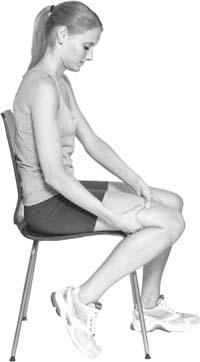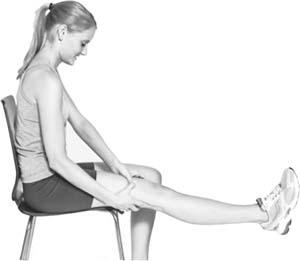Authors: Rob Destefano,Joseph Hooper
Tags: #Health & Fitness, #General, #Pain Management, #Healing, #Non-Fiction
Muscle Medicine: The Revolutionary Approach to Maintaining, Strengthening, and Repairing Your Muscles and Joints (39 page)

ANTERIOR THIGH
See page 186.
LATERAL THIGH
Purpose:
To self-treat the iliotibial band (ITB). This is important for movement and stabilization of the knee. The IT band can adhere to the vastus lateralis, causing dysfunction in that muscle and causing friction at the IT band’s attachment at the knee.

Starting out:
Sit with both feet on the floor and the treatment leg bent to forty-five degrees. Using both hands, apply pressure down onto the IT band and angle the pressure either up toward the body or down toward the knee. There is one zone, running along the lateral leg from the knee to the hip. Start working about three inches up from the knee and at three-inch intervals from there.
How to do it:
Maintaining the angled pressure, extend your leg. A F.A.S.T. Stick™ or other tool can also be used to apply pressure. Repeat with your other leg.
Troubleshooting:
This self-treatment has to be slow without too much pressure as the tendon can become irritated. Gentle pressure should help relieve tightness, which can occur between the tendon and the underlying muscles.

POSTERIOR THIGH
See page 183.
See also self-treatment for the tibialis anterior on page 223.
ANTERIOR THIGH
See page 191.
LATERAL THIGH
(See illustrations on page 191.)
Purpose:
To warm up and lengthen the IT band and the structures around it. This is the same as the quadriceps stretch with a variation.
Starting out:
Start out lying on your side with both knees pulled to the chest. Your bottom leg should be held at the knee, and the top, treatment leg should be held at the ankle.
How to do it:
Bring the treatment leg back, foot first so that the heel is closer to the glutes. Drop the leg down, allowing it to sink as far to the floor as is comfortable. Switch sides and repeat with your other leg. This should be held for two seconds only. Repeat ten times.
Troubleshooting:
Be sure to keep your bottom leg stable and pulled to the chest. If the ankle of the treatment leg can’t be comfortably grasped and moved, use a rope or band. Stop immediately if there is uncomfortable pressure in the knee or hip joint.
POSTERIOR THIGH
See page 187.
ANTERIOR THIGH
See page 195.
LATERAL THIGH
The IT band is a tendon, not a muscle. Connective tissue can be treated and stretched, but it cannot be strengthened like a muscle. Exercises that generally contribute to IT band strength appear in the hipexercises section (pages 193–196).
POSTERIOR THIGH
See page 192.
FULL BODY/CORE
A. SINGLE-LEG TOE TOUCH
See page 167.
B. KETTLE BELL SWING
See page 168.
C. BODY-WEIGHT SQUAT
See page 194.
D. SQUAT WITH KETTLE BELL
See page 195.

THE ANKLE AND THE FOOT

INTRODUCING THE ANKLE AND THE FOOT
The last hot spot, the ankle and the foot, is of course where your body makes contact with the ground, roughly five thousand to ten thousand times a day. That’s an amazing amount of pounding. You want that foot plant to be stable and secure,
SPORTS PODIATRIST DAN GELLER
Health professionals are going to see what they’re trained to see. Some orthopedists may not be interested in a case unless there’s a surgical issue. The podiatrist is going to say, “You’re pronating, that’s the root of all evil.” But as an athlete, I know there’s not just one fix. Orthotics can be a great adjunct, but they can be overprescribed or wrongly prescribed—as when the material or the design doesn’t fit the foot in question. And just because someone is injured, doesn’t mean they need an orthotic. Maybe they need to replace their shoes, stop training so hard, and stay off the hills for a while. As a clinician, you have to get out of the mind-set of wanting to be the hero by fixing them. You’re really doing the right thing when you put the patient in the right hands. For instance, some of my patients have done really well working on muscular issues with Dr. DeStefano.
especially if you’re active in sports. If this first link in the kinetic chain is weak—if something is off about the way bones, joints, and muscles work together to move you around—the impact that travels up through the foot and the ankle will likely result in some kind of lower-extremity injury. It could be an overuse injury. When the connective tissue that forms the major arch in the foot gets inflamed, it’s called plantar fasciitis. When the outer shinbone tissue gets irritated, it’s medial tibial stress syndrome, or shin splints. Or it could be a trauma. You step in a pothole and turn your ankle, and the ligaments and muscles aren’t resilient enough to prevent an ankle sprain, the single most common musculoskeletal injury. Chicago Bulls all-time great Michael Jordan was famous for avoiding the foot and leg injuries that often sideline pro basketball players. Every day he would religiously do stretching and strengthening exercises similar to the ones you’ll find at the end of this chapter.
The ankle is a pretty simple design. Technically speaking, it’s a mortise joint,
mortise
being a carpentry term for the space that something else fits into. The two bones of the lower leg, the tibia and the fibula, create a squarish space that houses the ankle bone or talus. The foot, by contrast, is an incredibly complex collection of 26 bones (almost one-fourth of the body’s total), 33 joints, 107 ligaments, and more than 7,000 nerve endings. Together, they make an effective combo.
As your foot makes contact with the ground, the ankle flexes, then the calf
muscles contract and push your weight onto the balls of the foot and the toes, propelling you forward. The foot’s bones, ligaments, and muscles support the entire weight of your body, or up to eight times your body weight if you’re running. What makes this possible is the curved architecture of the foot—three arches that absorb shock by flattening on impact, then springing back to their original shape during push off. The ankle’s side-to-side flexibility allows the foot to find a stable platform as it moves through uneven terrain. Ligaments on both the inside and the outside of the ankle are the key structural element that holds the ankle bones in place as you suddenly change direction when running. If the foot turns too far to either side (usually twisting to the outside in a stumble), the all-too-common ankle sprain is the result.
As you’ve seen in our discussion of the other hot spots, musculoskeletal problems are conventionally divided up between orthopedists, who concentrate on structural damage, and physical and muscle therapists, who work on muscles. (This entire book is an argument against this either/or thinking, since most injuries are a specific mix of both muscular and structural elements.) The foot/ankle hot zone is sufficiently complicated to support a third group of health professionals, the podiatrists, who zero in on the biomechanics of the foot, typically problems with the arches. The distinctive tool in their toolbox is the prescription arch support, or
IMMEDIATE TREATMENT/WHEN TO SEE A DOCTOR
It’s often hard to tell whether you’ve sprained or broken the ankle. But if you can’t put weight on it, it’s likely either a severe sprain or a fracture. Get medical treatment. As with any joint problem, check for any signs of infection—redness, heat or fever, and pain not connected to changes in activity. If there are any, see a doctor immediately. When the dire possibilities have been ruled out, you can assume you’ve got some kind of less serious soft-tissue damage, a ligament sprain or muscle strain. The normal rules of RICE apply: Rest (keep weight off the area); Ice it; keep inflammation down with Compression (a compression bandage); and Elevation (bring the affected area above the level of your heart).


